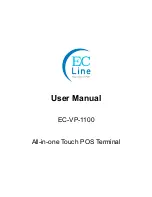
System Overview
5
2.4 Proximity sensor
The terminal is equipped with a proximity sensor. If the terminal is not in use, it switches to
(power-saving) sleep mode. When someone approaches the terminal, it wakes up and is immediately
available.
2.5 Encryption of data transfer
Transmission, credential <-> reader/terminal
The transmission of data between the credential and the reader/terminal is subject to requirements which
are constantly changing. Interflex is always up-to-date in supporting the current credential and reader
technologies.
Transmission, reader/terminal <-> controller
Transmission, controller <-> host system
You can activate and deactivate the encryption for this data link in the host system. You will find details in
the documentation of the host system.
See also
Setting interfaces, booking memory and encryption .............................................................. 10
2.6 Cable lengths and cable types
Cable Function
Max. Length
Recommended Cable
Type
230 VAC power supply to power supply unit
(if not preinstalled)
NYM 3 x 1.5 mm²
Network cabling: RJ45 patch cable, preferably shield
braiding
25 m
As of cat. 5
Cable to floating status contacts, control cable
100 m
JY(ST)Y 2 x 2 x 0.6 mm²
RS-485 bus cable to parent or child devices
1,200 m
JY(ST)Y 2 x 2 x 0.6 mm²
RS-485 branch cable to bus cable
100 m
JY(ST)Y 2 x 2 x 0.6 mm²
Cable lengths: The specifications indicate the maximum permitted cable lengths that guarantee
reliable function.
Cable types: Install only data and control cables with cable shielding, e.g., cable type JY(ST)Y.
Power loss in long cables can affect the function of the connected device. If cable lengths exceed 50
m, we recommend connecting "+5V" and "GND" with two conductors each.
2.7 Shielded cables
To ensure malfunction-free operation, we recommend the use of shielded bus cables.
Operation is also possible with unshielded cables. In case of transmission problems, you will have to
examine the reasons in each case. Where necessary, a shielded cable should be used for the connection
of the respective devices.
2.8 Online/offline mode
Online mode
In this operating mode, data is continuously exchanged between the
IF-57xx
device and the parent host
system (e.g. the IF-60x0 system). In the process, the host system causes the status of the
IF-57xx
device
to be cyclically queried. The
IF-57xx
device acknowledges the query either by sending a “sign of life” or
status messages or booking data from the terminals.








































